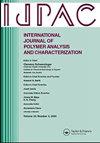A comprehensive study on the mechanical qualities of FDM 3D printed coconut wood-polylactic acid composite
IF 1.6
4区 工程技术
Q4 POLYMER SCIENCE
International Journal of Polymer Analysis and Characterization
Pub Date : 2025-10-03
DOI:10.1080/1023666X.2025.2504553
引用次数: 0
Abstract
The field of additive manufacturing is experiencing significant growth, transitioning from primarily serving as a prototyping service to becoming a full-fledged manufacturing service. Fused deposition modeling (FDM) printers have emerged as the predominant 3D printer in the current market landscape, driven by a notable surge in sales. Various industries have widely adopted these processes to manufacture limited quantities of intricate and personalized components. However, finding the optimal process parameters is complex due to inherent conflicts between various factors. One significant drawback of existing literature on selecting the most suitable parameters is the inadequate precision in estimating product quality. In this study, the properties of PLA and PLA/coconut wood (CT.W) are investigated and the appropriate parameters for various mechanical properties are determined. The specimens in this study vary in parameters, including infill pattern (grid, octagram spiral, rectilinear, honeycomb, and concentric) and infill percentage (25%, 50%, and 75%). The findings indicate that PLA and PLA/Ct.W specimens with 75% infill density and concentric infill pattern exhibit higher energy absorption in tensile, flexural, and impact properties. When comparing the properties of the PLA composite, it is observed that they are slightly lower due to the larger size of the coconut wood particles.
FDM 3D打印椰木-聚乳酸复合材料力学性能综合研究
增材制造领域正经历着显著的增长,从最初的原型设计服务转变为成熟的制造服务。在销售显著激增的推动下,熔融沉积建模(FDM)打印机已成为当前市场格局中占主导地位的3D打印机。各行各业都广泛采用这些工艺来制造数量有限的复杂和个性化部件。然而,由于各种因素之间的内在冲突,寻找最优工艺参数是复杂的。在选择最合适的参数方面,现有文献的一个重大缺点是估计产品质量的精度不足。本文研究了聚乳酸(PLA)和聚乳酸/椰子木(CT.W)的性能,并确定了各种力学性能的合适参数。本研究中试样的参数不同,包括填充模式(网格、八角形螺旋、直线、蜂窝和同心)和填充百分比(25%、50%和75%)。结果表明PLA和PLA/Ct。75%填充密度和同心填充模式的W试样在拉伸、弯曲和冲击性能上具有更高的能量吸收。当比较PLA复合材料的性能时,可以观察到由于椰子木颗粒的尺寸较大,它们略低。
本文章由计算机程序翻译,如有差异,请以英文原文为准。
求助全文
约1分钟内获得全文
求助全文
来源期刊
CiteScore
3.50
自引率
5.30%
发文量
37
审稿时长
1.6 months
期刊介绍:
The scope of the journal is to publish original contributions and reviews on studies, methodologies, instrumentation, and applications involving the analysis and characterization of polymers and polymeric-based materials, including synthetic polymers, blends, composites, fibers, coatings, supramolecular structures, polysaccharides, and biopolymers. The Journal will accept papers and review articles on the following topics and research areas involving fundamental and applied studies of polymer analysis and characterization:
Characterization and analysis of new and existing polymers and polymeric-based materials.
Design and evaluation of analytical instrumentation and physical testing equipment.
Determination of molecular weight, size, conformation, branching, cross-linking, chemical structure, and sequence distribution.
Using separation, spectroscopic, and scattering techniques.
Surface characterization of polymeric materials.
Measurement of solution and bulk properties and behavior of polymers.
Studies involving structure-property-processing relationships, and polymer aging.
Analysis of oligomeric materials.
Analysis of polymer additives and decomposition products.

 求助内容:
求助内容: 应助结果提醒方式:
应助结果提醒方式:


